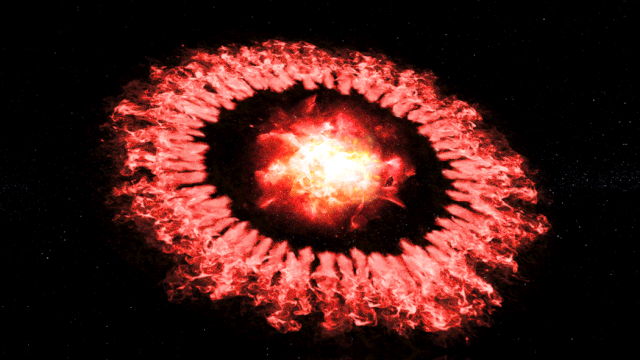Huge Supernova Explosion Leaves Surprisingly Dusty Aftermath

The aftermath of a massive stellar explosion turns out to be much dustier than scientists expected, recent NASA observations revealed.
When a red giant star nears the end of its life, it sheds its outer layers, creating interstellar clouds of cosmic dust. Eventually, when the star dies, a fiery explosion known as a supernova releases powerful blast waves that destroy almost everything in their path.
However, observations from NASA's flying telescope — the Stratospheric Observatory for Infrared Astronomy (SOFIA) — showed more than 10 times the amount of dust expected in the wake of a nearby stellar explosion called supernova 1987A.
Related: Diary of a Supernova: How (Some) Stars Blow Up
That supernova is located in the Large Magellanic Cloud and is named for the year in which it was discovered. At that time, the event was the brightest supernova seen in nearly 400 years. Since its discovery more than 30 years ago, astronomers have been able to closely monitor how the iconic supernova has changed its environment.
"We already knew about the slow-moving dust in the heart of 1987A. It formed from the heavy elements created in the core of the dead star," Mikako Matsuura, lead author of the study and senior lecturer at Cardiff University in Wales, said in a statement from NASA. "But the SOFIA observations tell us something new about a completely unexpected dust population."
The supernova has a distinctive set of rings that are part of a cavity created before the star exploded. Previously, astronomers believed that dust particles in these rings would have been destroyed by the powerful blast waves from the supernova.
Get the Space.com Newsletter
Breaking space news, the latest updates on rocket launches, skywatching events and more!
Instead, the SOFIA observations showed a growing population of dust in the rings. That, in turn, suggested that dust particles can re-form or grow rapidly in the wake of a supernova, according to the statement.
The findings, published in the Monthly Notices of the Royal Astronomical Society journal, revealed new clues about the abundance of dust in our galaxy and shed new light on how dust moves through space.
The team will continue to use the SOFIA telescope to learn more about dust creation and the evolution of supernova remnants. NASA's James Webb Space Telescope, which is slated to launch in March 2021, will also be used to further investigate the cosmic dust surrounding supernova 1987A.
Follow Samantha Mathewson @Sam_Ashley13. Follow us on Twitter @Spacedotcom and on Facebook.
Join our Space Forums to keep talking space on the latest missions, night sky and more! And if you have a news tip, correction or comment, let us know at: community@space.com.

Samantha Mathewson joined Space.com as an intern in the summer of 2016. She received a B.A. in Journalism and Environmental Science at the University of New Haven, in Connecticut. Previously, her work has been published in Nature World News. When not writing or reading about science, Samantha enjoys traveling to new places and taking photos! You can follow her on Twitter @Sam_Ashley13.









